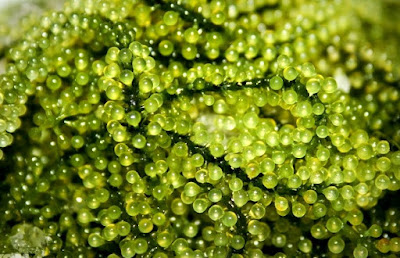Top 10 Rare Plants Found in the Ocean
The ocean, with its vastness and depth, is home to a multitude of plant species that have evolved to thrive in its unique environment. While some marine plants are commonly known, there are several rare and fascinating species that deserve attention. In this article, we will explore the top 10 rare plants found in the ocean, shedding light on their characteristics, habitats, and ecological importance.
1: Neptune's Cup (Sertularia cupressina)
Neptune's Cup, scientifically known as Sertularia cupressina, is a rare and captivating plant found in the ocean. It has a distinctive appearance, resembling a delicate cup made of interconnected branches. These plants typically inhabit deeper waters, attaching themselves to rocks or other substrates. Neptune's Cup plays a crucial role in marine ecosystems by providing shelter and habitat for various marine organisms.
2: Pink Seagrass (Halophila decipiens)
Pink Seagrass, scientifically known as Halophila decipiens, is a beautiful and rare marine plant with vibrant pink leaves. It thrives in shallow coastal areas and can form extensive underwater meadows. Pink Seagrass is a valuable habitat for juvenile fish and other marine creatures, providing them with food and shelter.
3: Feather Boa Kelp (Egregia menziesii)
Feather Boa Kelp, scientifically known as Egregia menziesii, is an extraordinary kelp species found in the ocean. Its long, slender fronds resemble feathery boas, swaying gracefully with the ocean currents. Feather Boa Kelp forms dense underwater forests, providing habitat for numerous marine organisms and contributing to coastal biodiversity.
4: Glasswort (Salicornia europaea)
Glasswort, scientifically known as Salicornia europaea, is a unique plant that thrives in salt marshes and coastal areas. It has succulent stems and leaves and can tolerate high levels of salinity. Glasswort plays a vital role in coastal ecosystems by stabilizing shorelines, preventing erosion, and providing food and habitat for wildlife.
5: Caulerpa Mexicana (Caulerpa mexicana)
Caulerpa Mexicana, scientifically known as Caulerpa mexicana, is an exotic and rare algae species found in the ocean. It has vibrant green fronds that resemble delicate ferns. Caulerpa Mexicana is an important food source for marine herbivores and contributes to the overall health and balance of marine ecosystems.
6: Sea Pen (Virgularia gustaviana)
Sea Pen, scientifically known as Virgularia gustaviana, is an intriguing and uncommon marine plant resembling a feather pen. It belongs to a group of soft corals and can be found in various ocean habitats, including sandy bottoms and rocky reefs. Sea Pens provide refuge and shelter for small fish and invertebrates, contributing to the biodiversity of the ocean floor.
7: Red Algae (Porphyra umbilicalis)
Red Algae, scientifically known as Porphyra umbilicalis, is a fascinating and rare marine plant that thrives in intertidal zones. It has thin, translucent fronds that range in color from reddish-brown to purple. Red Algae is edible and is commonly used in various culinary preparations, including sushi wraps. It also plays a role in nutrient cycling and provides habitat for small marine organisms.
8: Giant Kelp (Macrocystis pyrifera)
Giant Kelp, scientifically known as Macrocystis pyrifera, is a magnificent and rare species of brown algae found in the ocean. It forms colossal underwater forests, with long, leaf-like fronds reaching towards the surface. Giant Kelp provides habitat, food, and shelter for a wide variety of marine life, including fish, sea otters, and sea birds.
9: Sea Grapes (Caulerpa lentillifera)
Sea Grapes, scientifically known as Caulerpa lentillifera, are a unique and rare type of seaweed found in the ocean. They have small, grape-like structures attached to long stalks and are commonly found in tropical and subtropical regions. Sea Grapes are rich in nutrients and are consumed as a delicacy in many Asian countries. They also contribute to coral reef ecosystems by providing food and habitat for marine organisms.
10: Red Gorgonian (Paramuricea clavata)
Red Gorgonian, scientifically known as Paramuricea clavata, is a captivating and endangered species of soft coral found in the ocean. It forms beautiful colonies with branching structures, colored in vibrant shades of red or orange. Red Gorgonians provide habitat and protection for numerous marine species and are essential components of deep-sea ecosystems.
Conservation of Rare Ocean Plants:
Rare ocean plants face numerous threats due to human activities, including pollution, habitat destruction, and climate change. It is crucial to recognize the importance of conserving these unique species and the habitats they depend on. Efforts should be made to raise awareness, support marine protected areas, and promote sustainable practices to ensure the long-term survival of these rare ocean plants.
Conclusion:
The ocean is a treasure trove of rare and extraordinary plant species. From the enchanting Neptune's Cup to the vibrant Sea Grapes, each plant plays a significant role in the intricate web of marine life. By understanding and protecting these rare ocean plants, we can contribute to the preservation of marine biodiversity and the health of our oceans.
FAQs
FAQ 1: What makes a plant rare in the ocean?
Rare plants in the ocean are characterized by their limited distribution, low abundance, or unique features that set them apart from common species.
FAQ 2: How are rare ocean plants different from land plants?
Rare ocean plants have adapted to thrive in the marine environment, facing unique challenges such as saltwater, strong currents, and varying light levels.
FAQ 3: Are rare ocean plants endangered?
Some rare ocean plants are indeed endangered due to habitat destruction, pollution, and climate change. Conservation efforts are crucial to protect these vulnerable species.
FAQ 4: Can rare ocean plants be cultivated in aquariums?
While some rare ocean plants can be cultivated in specialized aquariums, many require specific conditions that can be challenging to replicate outside their natural habitat.
FAQ 5: How can individuals contribute to the conservation of rare ocean plants?
Individuals can contribute to the conservation of rare ocean plants by supporting marine protected areas, reducing pollution, practicing sustainable fishing, and spreading awareness about the importance of marine biodiversity.
























0 Comments